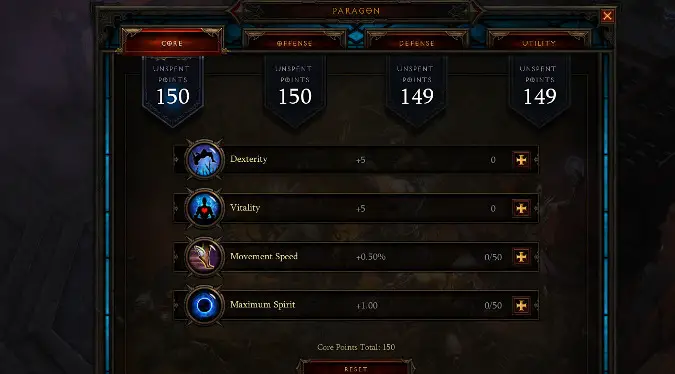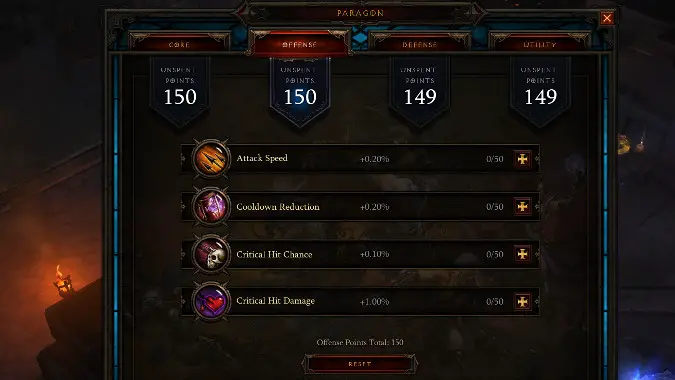What are Paragon levels in Diablo 3?

In essence, leveling in Diablo 3 takes two separate paths. The first pathway is a straightforward one — as of the Reaper of Souls expansion, you collect experience points to go from level 1 to level 70 over the course of five acts, four of which contain the main story of Diablo 3 and the fifth consisting of all the story from Reaper of Souls. And that’s great, but once you hit level 70, there’s a separate method of progression, one that isn’t tied to an individual character.
Paragon levels are account based, meaning that once you earn a Paragon level on your level 70 Demon Hunter, your level 3 Monk and level 28 Wizard will also have the same Paragon levels. This can lead to your having a brand new level 1 alt but that character will have just as many Paragon levels as your main does.
Okay, so what does that all mean? What are Paragon levels? Let’s discuss the end of game leveling system that adds more punch to your characters across the board, not just to one specific character.
Are you a Paragon?
Paragon levels are, in essence, an alternative progression model that rewards you for playing at max level and allows you to get stronger on all of your characters while earning those Paragon levels. If you have three level 70 characters, and you spend a variable amount of time playing each of them, all three will end up with the same Paragon levels. Every point of experience you earn after you hit level 70 on a character goes towards raising your Paragon levels, and once those levels are raised, they’ll apply equally to all the characters on your account. If you’re at Paragon 317 on your main? That level 2 Witch Doctor you started two years ago and haven’t touched since will also have 317 Paragon levels.

The Virtues of the Paragons
Paragon levels work differently than leveling 1 to 70. Going up a level provides a broad array of increases — health, damage, regen, etc. Going up a Paragon level gives you a point to spend in one of four categories. When you gain a Paragon level, you get a point in one of these four tiers, starting at Paragon level 1 giving you a point to spend in Core, 2 giving you a point in Offense, 3 a point in Defence allows you to spend points as follows:
- Strength, Dexterity or Intelligence — Whichever of these is your classes primary damage stat. In the screenshot above, a Monk, it’s Dexterity, as it would also be for Demon Hunters. Wizards, Witch Doctors and Necromancers gain Intelligence, while Barbarians and Crusaders can choose to spend points on Strength. In any case, damage is usually increased by 1% per point, so spending 1 Paragon point to get +5 of your primary damaging stat will get you an extra 5% damage. There are other benefits as well — for example, Armor also increases when you gain points in Strength, so Barbarians and Crusaders can get more Armor by increasing Strength, while Monks and Demon Hunters can increase their Dodge by boosting their Dexterity and Wizards, Necromancers and Witch Doctors can increase their Resitances by boosting their Intelligence. As befits one of the most powerful choices in your Core Paragon tier, this stat has no upper limit. You can keep spending points here indefinitely.
- Vitality — This buffs your Life and thus how much damage you can take before you die. Also has no upper limit — you can buy Vitality indefinitely with Paragon points.
- Movement Speed — This one is straightforward, half a percentage point increased movement speed for every point spent. This one caps at 50 points, giving a maximum increase of 25% movement speed at max investment.
- Maximum Resource — This one also caps at 50 points, and adds a different amount depending on class since it goes by the Resource used by said class. For example, spending the full 50 points on Maximum Spirit for a Monk gets you 50 points of Spirit, while spending the same amount on Maximum Hatred for a Demon Hunter only gets you an upper limit of 25 more Hatred. Check your class when spending points here to see exactly how much a point is worth.
After Core, there are tiers for Offense, Defense and Utility. You may be tempted to skip these tiers and go for the Core increases, but you can’t — remember that every Paragon level alternates between one of the four tiers and you can’t spend a Core point in Offense or Defense or Utility, and the same goes for Offense points or Ultility points or Defense points. There’s an exception — the only two choices in the Paragon system that don’t have a cap are your Primary Attribute and Vitality over in Core. Once you’ve accumulated roughly 800 Paragon levels, you will have maxed out every other possible option besides those two in Core, and thus, you’ll stop getting any points in Offense, Defense and Utility. From Paragon 800 on, all of your Paragon levels will go straight into Core, where you’ll choose between your Primary Attrribute and Vitality indefinitely. Considering that your Primary Attribute will add something like 1% damage per point and you get five points per Paragon spent, the Primary Attribute is likely your best bet, especially after Paragon 800.

The means to the end
Offense, Defense and Utility are more straighforward, and all of the options cap out so you’ll eventually have all 50 points in each four options per tier. What works best to focus on first depends both on your class and the specific build you’re going for. Offense offers Attack Speed, Cooldown Reduction, Critical Hit Chance and Critical Hit Damage. Defence gives you Life, Armor, Resist All and Life Regeneration, and Utility brings Area Effect Damage, Resource Cost Reduction, Life on Hit and Gold Find. What you choose to focus on is up to you and will be influenced by your gearing and build, but in general I’d almost always go with Cooldown Reduction first in Offense, Life Regeneration first in Defense, and either Area Effect or Resource Cost Reduction in Utility, although Life on Hit is also a strong contender. Eventually you’ll have them all maxed out and will be spending your remaining Paragon points on your Primary Attribute and Vitality anyway.
So the Paragon system means that there is no point where you’re ever really done. The amount of Paragon XP you need per level increases every level until around Paragon 2000 or so, which may not be a concern for you depending on how much you play — I’m not even at Paragon 800 yet and I play frequently, but I do Seasons and Season XP doesn’t add to your normal or Hardcore Paragon, and likewise Hardcore characters Paragon is shared between all Hardcore characters on your account, not with any normal mode characters you play. In general it’s not really worth worrying too much about it — chasing super high levels of Paragon is something that you either have the time for, or you don’t.
So yeah, Paragon levels are a useful way to increase your power directly through gameplay and aren’t really all that complex in actual practise — you get XP, you level, you get a point, you spend it. They share between characters, so if you decide you love your Barbarian for a few months and then go back to your Demon Hunter, all the Paragon XP that Barb earned and the Paragon levels they ground out will apply to your DH as well, as long as they’re not from a different mode of play. So go ahead and start grinding them up.
Originally published 5/15/2019. Updated 1/13/2021.
Please consider supporting our Patreon!
Join the Discussion
Blizzard Watch is a safe space for all readers. By leaving comments on this site you agree to follow our commenting and community guidelines.
 @MatthewWRossi
@MatthewWRossi



